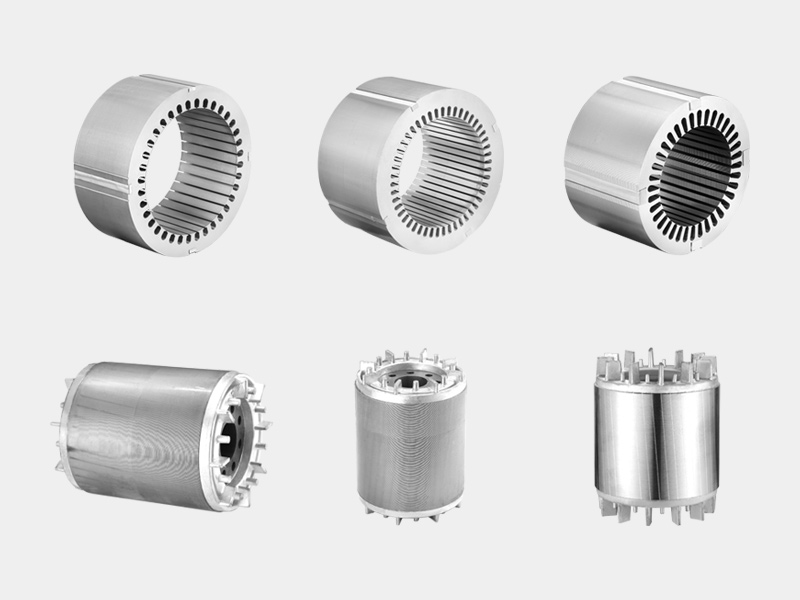Electric motors are essential components in various industries, from automotive to industrial automation. One critical aspect of motor manufacturing is the lamination stacking process, which significantly impacts motor performance, efficiency, and durability. This article explores the common motor lamination stacking methods and their associated benefits, providing insights into why this process is vital for high-quality motor production.
1. Introduction to motor lamination stacks
Motor laminations are thin, insulated steel sheets stacked together to form the stator or rotor core. These laminations reduce energy losses caused by eddy currents, which occur when alternating current flows through conductive materials. By stacking insulated laminations instead of using a solid core, manufacturers minimize heat generation and improve motor efficiency.
The stacking methods used during assembly influence the motor's magnetic properties, mechanical strength, and thermal performance. Below, we discuss the most common techniques and their advantages.
2. Common Motor Lamination Stacking Methods
2.1. Interlocking (Self-Stacking) Method
The interlocking method involves laminations with small tabs or notches that lock into each other when stacked. This eliminates the need for welding or adhesives, simplifying assembly.
Benefits:
- Reduced manufacturing time – No additional bonding steps are required.
- Improved alignment – The interlocking tabs ensure precise stacking, minimizing misalignment.
- Cost-effective – Eliminates the need for welding or gluing materials.
However, interlocking may slightly increase magnetic flux leakage due to the gaps created by the tabs.
2.2. Welding Method
In this approach, laminations are stacked and then welded at specific points to secure them. Spot welding or laser welding is commonly used.
Benefits:
- High mechanical strength – Welding provides a rigid structure, reducing vibration-related issues.
- Good thermal conductivity – Metal-to-metal contact improves heat dissipation.
- Suitable for high-speed motors – The welded stack can withstand centrifugal forces better than glued stacks.
Drawbacks:
- Welding may introduce localized heat stress, affecting magnetic properties.
- Higher production costs due to welding equipment and energy consumption.
2.3. Adhesive Bonding (Gluing) Method
Adhesive bonding uses epoxy or other specialized glues to hold laminations together. This method avoids the heat stress associated with welding.
Benefits:
- No thermal distortion – Unlike welding, gluing does not alter the magnetic properties of the steel.
- Reduced vibration and noise – The adhesive dampens vibrations, making the motor quieter.
- Uniform stacking – Glue ensures even pressure distribution across laminations.
Challenges:
- Longer curing time increases production cycle time.
- Adhesive strength may degrade under high temperatures.

2.4. Riveting Method
Riveting involves inserting small rivets through aligned holes in the laminations to hold them together.
Benefits:
- Strong mechanical bond – Rivets provide excellent structural integrity.
- No heat application – Avoids thermal deformation risks.
Limitations:
- Rivet holes may slightly disrupt magnetic flux paths.
- Requires precise hole alignment, increasing manufacturing complexity.
2.5. Press-Fit (Shrink-Fit) Method
In this method, laminations are pressed onto a shaft or housing with tight tolerances, creating a secure fit without additional fasteners.
Benefits:
- No additional bonding materials needed – Reduces material costs.
- Good heat transfer – Metal-on-metal contact aids in thermal management.
Drawbacks:
- High precision is required in machining components.
- May lead to stress concentrations if not properly designed.
3. Key Benefits of Proper Lamination Stacking
Regardless of the stacking method used, proper lamination assembly offers several advantages:
3.1. Reduced Eddy Current Losses
Laminations are coated with insulating materials (e.g., varnish or oxide layers) to prevent eddy currents. Proper stacking ensures minimal gaps, further enhancing efficiency.
3.2. Improved Motor Efficiency
By minimizing energy losses, well-stacked laminations contribute to higher motor efficiency, reducing operational costs.
3.3. Enhanced Thermal Performance
Efficient stacking allows better heat dissipation, preventing overheating and prolonging motor life.
3.4. Lower Noise and Vibration
Tightly secured laminations reduce vibration, resulting in quieter motor operation.
3.5. Cost Savings in Manufacturing
Optimized stacking methods (e.g., interlocking or gluing) can reduce labor and material costs compared to welding or riveting.
4. Factors Influencing Stacking Method Selection
When choosing a stacking method, manufacturers consider:
- Motor application (e.g., high-speed vs. low-speed motors).
- Production volume (mass production may favor interlocking, while custom motors may use welding).
- Cost constraints (adhesives vs. welding costs).
- Performance requirements (thermal, mechanical, and magnetic properties).
5. Conclusion
The motor lamination stacking method plays a crucial role in determining motor performance, efficiency, and durability. Whether using interlocking, welding, gluing, riveting, or press-fit techniques, each approach has unique benefits tailored to specific applications. By understanding these methods, manufacturers can optimize motor design for better energy efficiency, reduced losses, and longer service life.
As motor technology advances, innovations in lamination materials and stacking processes will continue to enhance electric motor performance across industries.

Copyright © Zhejiang Xinzheng Electromechanical Technology Co., Ltd. All Rights Reserved.
This website uses cookies to ensure you get the best experience on our website.
Comment
(0)